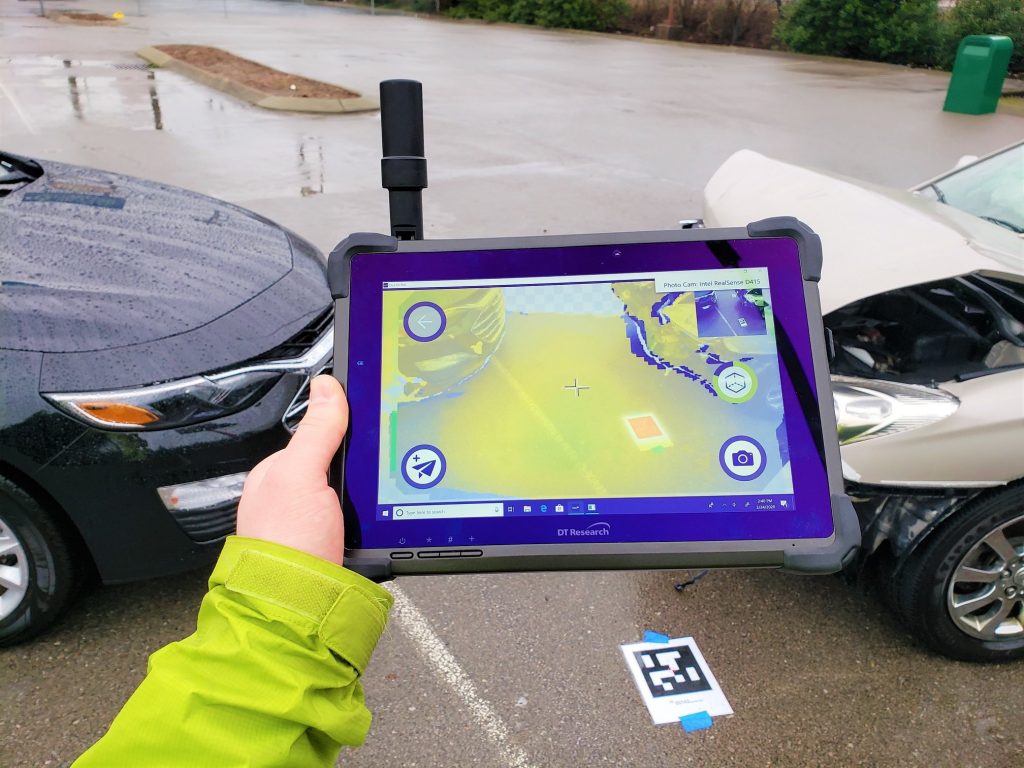
Crash scene investigators rely on the accuracy of information from the incident to reconstruct the scene once the debris from the site has been cleaned up. First responders rely on cleaning up the scene with speed in order to restore traffic flow and avoid another accident. There are many details that need to be collected from the location of an accident including pictures, documentation from witnesses, and measurements of the details from the scene.
Rugged tablets make it possible to accurately document and process a crash scene to restore normalcy quickly while also gathering the required data needed to reconstruct the scene at a later time. Rugged tablets make it possible to collect information from the scene that is reliable in a court case, should the information need to stand up against prosecution.
Event Data Recorder
The use of the 3D RealSense camera integrated into rugged tablets for crash scene investigators at an accident location makes it possible to yield a complete reconstruction of a crash scene considering all available information. Event Data Recorder (EDR) can calculate the appropriate ranges for speed at impact, use time-distance analysis to estimate the point of first perception, and gains previously unavailable insight into driver behavior and approach speed.
The items collected at the time of the accident are crucial to determining who is at fault for the accident and how the accident happened. Measuring, scale diagramming, and photographing the scene is needed to ensure the accuracy of all data collected and to record physical evidence and essential facts available only at the crash scene.
Crash scene investigators must collect and analyze the information from the scene to determine what happened before, during, and after the collision, including:
- Physical evidence from the roadway
- Physical evidence from the vehicle
- The human element and occupant kinematics
- Mathematical principles and equations
- Skid marks and vehicle speeds
- Crash scene photography
- Traffic templates
- Measuring and scale diagramming
- Driver and witness interviews
- Information analysis and case preparation
Complex vehicle dynamics like acceleration/deceleration, factor, rate, and airborne situations must also be documented while at the scene. Investigators are required to estimate speeds from falls, vaults, and flips as well as the calculation of kinetic energy and linear momentum.
It is important to have the ability to evaluate vehicle lamps, tires, and damage to help determine vehicle behaviors during the collision including:
- Speed estimates from kinetic energy, skid marks, scuff marks, and airborne situations
- Vehicle dynamics and motion
- Time, distance, and motion equations
- Conservation of momentum equations
- Center of mass calculation
- Vehicle lamp examination
- Tire damage evaluation
- Vector sum analysis
DT Research rugged tablets make it possible to collect data with detailed accuracy by using the latest 3D RealSense camera technology integrated into one device that is rugged and built for durability. Rugged tablets are easy to use by first responders and make it so anyone on the network can communicate with each other in real-time.
All of this information needs to be processed quickly in order to secure a safe work environment for first responders and to restore traffic flow to avoid secondary accidents from onlookers. Rugged tablets make it possible to document and process accident scenes in a fourth of the time it takes investigators and first responders if they are doing it without the technology. Tablets also reduce the risk of human error or loss of information in transfer from scene to office, as they record the information and save it in real-time on the network. This improves the efficiency of workflow for all parties involved in using the data to reconstruct the scene.
First responders and crash scene investigators rely on dependable and portable devices to do their job more efficiently and effectively resulting in better decisions that ultimately can save lives.

